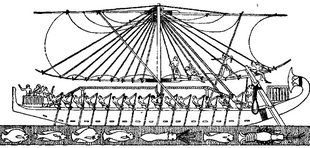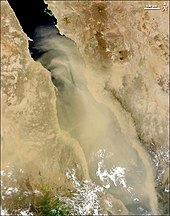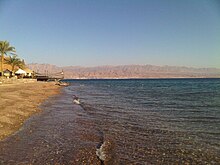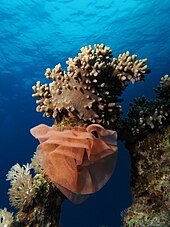Red Sea
| Red Sea | |
|---|---|
Bab el Mandeb | |
| Basin countries | |
| Max. length | 2,250 km (1,400 mi) |
| Max. width | 355 km (221 mi) |
| Surface area | 438,000 km2 (169,000 sq mi) |
| Average depth | 490 m (1,610 ft) |
| Max. depth | 3,040 m (9,970 ft) |
| Water volume | 233,000 km3 (56,000 cu mi) |
The Red Sea is a sea inlet of the Indian Ocean, lying between Africa and Asia. Its connection to the ocean is in the south, through the Bab-el-Mandeb strait and the Gulf of Aden. To its north lie the Sinai Peninsula, the Gulf of Aqaba, and the Gulf of Suez (leading to the Suez Canal). It is underlain by the Red Sea Rift, which is part of the Great Rift Valley.
The Red Sea has a surface area of roughly 438,000 km2 (169,000 sq mi),[1] is about 2,250 km (1,400 mi) long, and — at its widest point — 355 km (221 mi) wide. It has an average depth of 490 m (1,610 ft), and in the central Suakin Trough it reaches its maximum depth of 3,040 m (9,970 ft).[2]
Approximately 40% of the Red Sea is quite shallow (less than 100 m (330 ft) deep), and about 25% is less than 50 m (164 ft) deep.[not verified in body] The extensive shallow shelves are noted for their marine life and corals. More than 1,000 invertebrate species and 200 types of soft and hard coral live in the sea. The Red Sea is the world's northernmost tropical sea, and has been designated a Global 200 ecoregion.
Extent
The
Exclusive economic zone
| Number | Country | Area (Km2) |
|---|---|---|
| 1 | 186,392 | |
| 2 | 92,513 | |
| 3 | 91,279 | |
| 4 | 78,383 | |
| 5 | 35,861 | |
| 6 | 7,037 | |
| Total | Red Sea | 491,465 |
Note: Hala'ib Triangle disputed between Sudan and Egypt and calculated for both.
Names
Red Sea has names in many languages (Modern
The name in Hebrew Yam Suph (Hebrew: ים סוף, lit. 'Sea of Reeds') is of biblical origin. The name in Coptic: ⲫⲓⲟⲙ `ⲛϩⲁϩ Phiom Enhah ("Sea of Hah") is connected to Ancient Egyptian root ḥ-ḥ which refers to water and sea (for example the names of the Ogdoad gods Heh and Hauhet).[9]
Historically, it was also known to western geographers as Mare Mecca (Sea of Mecca), and Sinus Arabicus (Gulf of Arabia).[10] Some ancient geographers called the Red Sea the Arabian Gulf[11] or Gulf of Arabia.[12]
The association of the Red Sea with the
The Red Sea is one of four seas named in English after common color terms – the others being the Black Sea, the White Sea and the Yellow Sea. The direct rendition of the Greek Erythra thalassa in Latin as Mare Erythraeum refers to the north-western part of the Indian Ocean, and also to a region on Mars.
History
Ancient era

The earliest known exploration of the Red Sea was conducted by ancient Egyptians, as they attempted to establish commercial routes to Punt. One such expedition took place around 2500 BC, and another around 1500 BC (by Hatshepsut). Both involved long voyages down the Red Sea.[13]
The biblical Book of Exodus tells the account of the Israelites' crossing of the sea, which the Hebrew text calls Yam Suph (Hebrew: יַם סוּף). Yam Suph was traditionally identified as the Red Sea. Rabbi Saadia Gaon (882‒942), in his Judeo-Arabic translation of the Pentateuch, identifies the crossing place of the Red Sea as Baḥar al-Qulzum, meaning the Gulf of Suez.[14]

In the 6th century BC, Darius the Great, who was a prominent ruler of the Achaemenid Empire in Persia, undertook significant efforts to improve and extend navigation in the Red Sea. He sent reconnaissance missions to explore the Red Sea area and to identify its various navigational hazards, such as rocks and currents. This effort was significant, as it contributed to safer and more efficient navigation routes.[15]
In addition to the maritime explorations, during the reign of Darius the Great, a canal was constructed linking the Nile River to the northern end of the Red Sea at Suez. This canal is sometimes referred to as the ancient Suez Canal. It played a pivotal role in improving trade and communication between the Nile Valley and the Red Sea, and beyond to the Indian Ocean. This canal was a predecessor to the modern Suez Canal, which was constructed in the 19th century and continues to be one of the world's most important waterways.[16]
The construction of the canal during Darius's reign is evidenced by ancient records, including inscriptions. Darius commemorated the completion of the canal by creating stelae (stone monuments) with inscriptions in several languages, describing the construction and its benefits. The canal not only facilitated trade but also solidified Darius's control over Egypt and enhanced the Achaemenid Empire's economic and political power in the region.
In the late 4th century BC,
The Red Sea was favored for
Middle Ages and modern era
During the Middle Ages, the Red Sea was an important part of the spice trade route. In 1183, Raynald of Châtillon launched a raid down the Red Sea to attack the Muslim pilgrim convoys to Mecca.[20] The possibility that Raynald's fleet might sack the holy cities of Mecca and Medina caused fury throughout the Muslim world.[21] However, it appears that Reynald's target was the lightly armed Muslim pilgrim convoys, rather than the well guarded cities of Mecca and Medina, and the belief in the Muslim world that Reynald was seeking to sack the holy cities, due to the proximity of those cities to the areas that Raynald raided.[22]
In 1513, trying to secure that channel to Portugal,
After the
Iranian-backed Yemini
Oceanography

The Red Sea is between arid land,
The climate of the Red Sea is the result of two monsoon seasons: a northeasterly monsoon and a southwesterly monsoon. Monsoon winds occur because of differential heating between the land and the sea. Very high surface temperatures and high salinities make this one of the warmest and saltiest bodies of seawater in the world. The average surface water temperature of the Red Sea during the summer is about 26 °C (79 °F) in the north and 30 °C (86 °F) in the south, with only about 2 °C (3.6 °F) variation during the winter months. The overall average water temperature is 22 °C (72 °F). Temperature and visibility remain good to around 200 m (660 ft). The sea is known for its strong winds and unpredictable local currents.[citation needed]
The
Salinity
The Red Sea is one of the saltiest bodies of water in the world, owing to high evaporation and low precipitation; no significant rivers or streams drain into the sea, and its southern connection to the
Tidal range
In general, tide ranges between 0.6 m (2.0 ft) in the north, near the mouth of the Gulf of Suez and 0.9 m (3.0 ft) in the south near the Gulf of Aden, but it fluctuates between 0.20 m (0.66 ft) and 0.30 m (0.98 ft) away from the nodal point. The central Red Sea (Jeddah area) is therefore almost tideless, and as such the annual water level changes are more significant. Because of the small tidal range the water during high tide inundates the coastal sabkhas as a thin sheet of water up to a few hundred metres rather than flooding the sabkhas through a network of channels. However, south of Jeddah in the Shoiaba area, the water from the lagoon may cover the adjoining sabkhas as far as 3 km (2 mi), whereas north of Jeddah in the Al-Kharrar area the sabkhas are covered by a thin sheet of water as far as 2 km (1.2 mi). The prevailing north and northeast winds influence the movement of water in the coastal inlets to the adjacent sabkhas, especially during storms. Winter mean sea level is 0.5 m (1.6 ft) higher than in summer. Tidal velocities passing through constrictions caused by reefs, sand bars and low islands commonly exceed 1–2 m/s (3–7 ft/s). Coral reefs in the Red Sea are near Egypt, Eritrea, Israel, Saudi Arabia, and Sudan.[citation needed]
Current
Detailed information regarding current data is lacking, partially because the currents are weak and both spatially and temporally variable. The variation of temporal and spatial currents is as low as 0.5 m (1.6 ft)[clarification needed] and are governed all by wind. During the summer, northwesterly winds drive surface water south for about four months at a velocity of 15–20 cm/s (6–8 in/s), whereas in winter the flow is reversed resulting in the inflow of water from the Gulf of Aden into the Red Sea. The net value of the latter predominates, resulting in an overall drift to the north end of the Red Sea. Generally, the velocity of the tidal current is 50–60 cm/s (20–24 in/s) with a maximum of 1 m/s (3.3 ft/s) at the mouth of the al-Kharrar Lagoon. However, the range of the north-northeast current along the Saudi coast is 8–29 cm/s (3–11 in/s).[citation needed]
Wind regime
The north part of the Red Sea is dominated by persistent north-west
Wind is the driving force in the Red Sea to transport material as suspension or as bedload. Wind-induced currents play an important role in the Red Sea in resuspending bottom sediments and transferring materials from sites of dumping to sites of burial in quiescent environment of deposition. Wind-generated current measurement is therefore important in order to determine the sediment dispersal pattern and its role in the erosion and accretion of the coastal rock exposure and the submerged coral beds.[clarify][34]
Geology

The Red Sea was formed by the
Sometime during the
- A "race" between the Red Sea widening and .
- The lowering of world sea level during the Ice Ages because of much water being locked up in the ice caps.
A number of volcanic islands rise from the center of the sea. Most are dormant. However, in 2007,
Oil and gas
Undiscovered oil reserves in the region have been estimated at 5,041 MMBO. Undiscovered gas reserves in the region have been estimated at 112,349 BCFG. Undiscovered natural gas reserves have been estimated at 3,077 MMBNGL.[41] Most of these plays are controlled by the structure of the basin.[42] Normal faults are common as the Red Sea occupies an active diverging margin. These targets are commonly found below the Salt deposits of the middle Miocene.
Modern development is focused on the following fields. The Durwara 2 Field was discovered in 1963, while the Suakin 1 Field and the Bashayer 1A Field were discovered in 1976, on the Egyptian side of the Red Sea. The Barqan Field was discovered in 1969, and the Midyan Field in 1992, both within the Midyan Basin on the Saudi Arabian side of the Red Sea. The 20-m thick
Mineral resources

In terms of mineral resources the major constituents of the Red Sea sediments are as follows:
- Biogenic constituents:
- Nanofossils, pteropods, siliceous fossils
- Volcanogenic constituents:
- Terrigenous constituents:
- clay minerals
- Authigenic minerals:
- Sulfide minerals, aragonite, calcite, protodolomite, dolomite, quartz, chalcedony.
- Evaporite minerals:
- Brine precipitate:
- Fe-montmorillonite, goethite, hematite, siderite, rhodochrosite, pyrite, sphalerite, anhydrite.
Ecosystem


The Red Sea is a rich and diverse

The rich diversity is in part due to the 2,000 km (1,240 mi) of
It contains 175 species of nudibranch, many of which are only found in the Red Sea.[46]
The Red Sea also contains many offshore reefs including several true atolls. Many of the unusual offshore reef formations defy classic (i.e., Darwinian) coral reef classification schemes, and are generally attributed to the high levels of tectonic activity that characterize the area.
The special
The U.N. is working to mitigate the threat from the FSO Safer, a derelict oil tanker off the coast of Yemen that could possibly cause an enormous ecological disaster in the Red Sea.[48]
The
Desalination plants
There is extensive demand for desalinated water to meet the needs of the population and the industries along the Red Sea.
There are at least 18 desalination plants along the Red Sea coast of Saudi Arabia which discharge warm
Trade
The Red Sea serves an important role in the
Tourism

The sea is known for its
The Red Sea became a popular destination for diving after the expeditions of
.The popular tourist beach of Sharm el-Sheikh was closed to all swimming in December 2010 due to several serious shark attacks, including a fatality. As of December 2010, scientists are investigating the attacks and have identified, but not verified, several possible causes including over-fishing which causes large sharks to hunt closer to shore, tourist boat operators who chum offshore for shark-photo opportunities, and reports of ships throwing dead livestock overboard. The sea's narrowness, significant depth, and sharp drop-offs, all combine to form a geography where large deep-water sharks can roam in hundreds of meters of water, yet be within a hundred meters of swimming areas. The Red Sea Project is building highest quality accommodation and a wide range of facilities on the coast line in Saudi Arabia. This will allow people to visit the coastline of the Red Sea by the end of 2022 but will be fully finished by 2030.[54]
Tourism to the region has been threatened by occasional terrorist attacks, and by incidents related to food safety standards.[55][56]
Security
The Red Sea is part of the
Bordering countries

The Red Sea may be geographically divided into three sections: the Red Sea proper, and in the north, the Gulf of Aqaba and the Gulf of Suez. The six countries bordering the Red Sea proper are:
The Gulf of Suez is entirely bordered by Egypt. The Gulf of Aqaba borders Egypt, Israel, Jordan and Saudi Arabia.
In addition to the standard geographical definition of the six countries bordering the Red Sea cited above, areas such as Somalia are sometimes also described as Red Sea territories. This is primarily due to their proximity to and geological similarities with the nations facing the Red Sea and/or political ties with them.[59][60]
Towns and cities
Towns and cities on the Red Sea coast (including the coasts of the Gulfs of Aqaba and Suez) include:
- Ain Sokhna, Egypt (العين السخنة)
- Al Hudaydah, Yemen (الحديدة)
- Al Lith, Saudi Arabia (الليِّث)
- Al Qunfudhah, Saudi Arabia (القنفذة)
- Al-Qusair, Egypt (القصير)
- Al Wajh, Saudi Arabia (الوجه)
- Aqaba, Jordan (العقبة)
- Asseb, Eritrea (ዓሰብ / عصب)
- Dahab, Egypt (دهب)
- Duba, Saudi Arabia (ضباء)
- Eilat, Israel (אילת)
- El Gouna, Egypt (الجونة)
- El Tor, Egypt (الطور)
- Suez, Egypt (السويس)
- Hala'ib, Egypt and Sudan (حلايب) (disputed)
- Haql, Saudi Arabia (حقل)
- Hirgigo, Eritrea (ሕርጊጎ / حرقيقو)
- Hurghada, Egypt (الغردقة)
- Jeddah, Saudi Arabia (جدة)
- Jazan, Saudi Arabia (جازان)
- Marsa Alam, Egypt (مرسى علم)
- Massawa, Eritrea (ምጽዋዕ / مصوع)
- Mokha, Yemen (المُخا)
- Moulhoule, Djibouti (مول هولة)
- Nuweiba, Egypt (نويبع)
- Port Sudan, Sudan (بورت سودان)
- Rabigh, Saudi Arabia (رابغ)
- Safaga, Egypt (سفاجا)
- Sharm El Sheikh, Egypt (شرم الشيخ)
- Soma Bay, Egypt (سوما باي)
- Suakin, Sudan (سواكن)
- Taba, Egypt (طابا)
- Thuwal, Saudi Arabia (ثول)
- Yanbu, Saudi Arabia (ينبع)
See also
- Benjamin Kahn
- MS al-Salam Boccaccio 98 ferry disaster
- Crossing the Red Sea, a Biblical tale from the Book of Exodus
- Red Sea Dam
- Robert Moresby
Notes
References
- ^ "State of the Marine Environment Report for the Red Sea and Gulf of Aden: 2006" (PDF). 16 June 2008. Archived (PDF) from the original on 21 April 2021. Retrieved 25 January 2020.
- ISBN 978-0-7566-2205-3.
- ^ "Limits of Oceans and Seas, 3rd edition" (PDF). International Hydrographic Organization. 1953. Archived (PDF) from the original on 8 October 2011. Retrieved 28 December 2020.
- ^ "Sea Around Us | Fisheries, Ecosystems and Biodiversity". www.seaaroundus.org. Archived from the original on 23 February 2016. Retrieved 25 February 2021.
- from the original on 2 June 2023. Retrieved 2 June 2023 – via JSTOR.
- ^ "Red Sea | sea, Middle East". Encyclopedia Britannica Online Library Edition. Encyclopedia Britannica. Archived from the original on 23 January 2023. Retrieved 14 January 2008.
- ^ "How the Red Sea Got its Name". Archived from the original on 26 September 2019. Retrieved 20 July 2015.
- ^ Schmitt, Rüdiger (1996). "Considerations on the Name of the Black Sea". Hellas und der griechische Osten. Saarbrücken: 219–224.
- ^ Vycichl, Werner (1983). Dictionnaire Etymologique de La Langue Copte. Leuven: Peeters. p. 320.
- ^ "Arabia". World Digital Library. Archived from the original on 5 June 2013. Retrieved 11 August 2013.
- ISBN 978-0-8204-6716-0. Archivedfrom the original on 10 February 2023. Retrieved 19 November 2020.
- S2CID 242765347.
- ISBN 978-0-393-06259-5.
- ^ Tafsir, Saadia Gaon, s.v. Exodus 15:22, et al.
- ^ "Darius' Red Sea Canal Stele | cabinet". www.cabinet.ox.ac.uk. Archived from the original on 16 July 2023. Retrieved 8 June 2023.
- ^ Colburn, Henry (2021). "King Darius' Red Sea Canal". FEZANA Journal. 35 (4): 27–30. Archived from the original on 16 July 2023. Retrieved 8 June 2023.
- ISBN 978-0-393-06259-5.
- ISBN 978-0-393-00419-9.
- ^ The Palgrave Handbook of Global Slavery Throughout History. (2023). Tyskland: Springer International Publishing.
- from the original on 2 June 2023. Retrieved 2 June 2023.
- from the original on 2 June 2023. Retrieved 2 June 2023.
- from the original on 2 June 2023. Retrieved 2 June 2023.
- ISBN 978-0-415-23979-0.
- ISBN 978-81-7099-046-8. Archivedfrom the original on 10 February 2023. Retrieved 19 November 2020.
- ^ Sabbagh, Dan (10 January 2024). "Houthis call west's bluff with renewed Red Sea drone assault". The Guardian.
- ^ "Egyptian Dust Plume, Red Sea". earthobservatory.nasa.gov. 8 July 2013. Archived from the original on 22 February 2014. Retrieved 4 February 2014.
- .
- BBC 2television program "Oceans 3/8 The Red Sea", 8 pm–9 pm Wednesday 26 November 2008
- ^ "Virus power harnessed to protect Red Sea coral". New Scientist. Archived from the original on 23 April 2015. Retrieved 4 June 2023.
- BBC Future. Archivedfrom the original on 7 May 2022. Retrieved 24 May 2022.
- ISBN 978-94-009-0937-3. Archivedfrom the original on 10 February 2023. Retrieved 19 November 2020.
- ISBN 978-0-922769-04-9. Archivedfrom the original on 10 February 2023. Retrieved 19 November 2020.
- ISSN 0011-7471.
- ^ Morcos, S. A. (1970). "Physical and chemical oceanography of the Red Sea". Oceanography and Marine Biology Annual Review.
- ISBN 978-1-84-607505-6.
- ^ hdl:11573/1202448.
- ISBN 978-3-662-27120-9. Archivedfrom the original on 1 January 2024. Retrieved 2 June 2023.
- ^ "MSN – Outlook, Office, Skype, Bing, Breaking News, and Latest Videos". NBC News. 28 December 2011. Archived from the original on 10 February 2023. Retrieved 10 November 2019.
- ^ Israel, Brett (28 December 2011). "New Island Rises in the Red Sea". LiveScience.com. Archived from the original on 28 January 2022. Retrieved 31 July 2015.
- ^ Oskin, Becky; SPACE.com (30 May 2015). "Red Sea Parts for 2 New Islands". Scientific American. Archived from the original on 3 August 2015. Retrieved 31 July 2015.
- ^ Schenk, Christopher. World Petroleum Resources Project Assessment of Undiscovered Oil and ... https://pubs.usgs.gov/fs//2010/3119/pdf/FS10-3119.pdf Archived 7 January 2023 at the Wayback Machine .
- S2CID 221322448.
- ^ Lindquist, Sandra (1998). The Red Sea Province: Sudr-Nubia(!) and Maqna(!) Petroleum Systems, USGS Open File Report 99-50-A. US Dept. of the Interior. pp. 6–7, 9.
- ^ a b Froese, Rainer; Pauly, Daniel (2009). "FishBase". Archived from the original on 17 December 2020. Retrieved 12 March 2009.
- ISBN 978-88-87177-42-8.
- ^ Yonow, Nathalie (2012). "Nature's Best-Dressed". Saudi Aramco World. Vol. 63, no. 4. Aramco Services Company. pp. 2–9. Archived from the original on 20 December 2018. Retrieved 11 December 2018.
- ISBN 978-0-00-715986-4.
- ^ "UN buys huge ship to avert catastrophic oil spill off Yemen". BBC News. 9 March 2023. Archived from the original on 9 March 2023. Retrieved 9 March 2023.
- from the original on 1 January 2024. Retrieved 4 June 2023.
- ^ Rodrigue, Jean-Paul (1 November 2017). "Geographical Impacts of the Suez and Panama Canals". New York: Hofstra University. Archived from the original on 4 June 2023. Retrieved 4 June 2023.
- ^ a b c d Yerushalmy, Jonathan (20 December 2023). "Red Sea crisis explained: what is happening and what does it mean for global trade?". The Guardian. Retrieved 3 January 2024.
- ^ "Scuba Diving in Egypt – Red Sea – Dive The World Vacations". www.dive-the-world.com. Archived from the original on 23 June 2013. Retrieved 15 March 2013.
- ^ Philippe Cousteau Jnr (23 April 2010). Jacques Cousteau's underworld village in the Red Sea. BBC Earth. Archived from the original on 27 June 2018. Retrieved 11 December 2018.
- ^ "Saudi Arabia's 'The Red Sea Project' breaks ground on coastal village". Al Arabiya English. 20 April 2020. Archived from the original on 9 December 2020. Retrieved 4 December 2020.
- ^ Walsh, Declan; Karasz, Palko (24 August 2018). "Hundreds of Tourists Evacuated From Hotel in Egypt After Britons' Sudden Death". The New York Times. Archived from the original on 25 August 2018. Retrieved 26 August 2018.
- ^ Regev, Dana (15 July 2017). "Egypt's tourism industry suffers a critical blow". DW. Archived from the original on 16 July 2017. Retrieved 26 August 2018.
- ISSN 0013-0613. Retrieved 21 January 2024.
- ^ Fazeli, Yaghoub (16 January 2024). "Iran's Khamenei praises Houthis' Red Sea attacks, hopes they will continue". Alarabiya News. Retrieved 16 January 2024.
- ISBN 978-1-4020-0504-6.
- ISBN 978-0-7099-4662-5.
Further reading
- Dickson, Henry Newton (1911). . Encyclopædia Britannica. Vol. 22 (11th ed.). pp. 970–971.
- Hamblin, W. Kenneth & Christiansen, Eric H. (1998). Earth's Dynamic Systems (8th ed.). Upper Saddle River: Prentice-Hall. ISBN 978-0-13-745373-3.
- Miran, Jonathan. (2018). "The Red Sea," in David Armitage, Alison Bashford and Sujit Sivasundaram (eds.), Oceanic Histories (Cambridge: Cambridge University Press), pp. 156–181.
External links
- Red Sea Coral Reefs
- Red Sea Photography
- Potts, D.T.; Gillies, Sean; Scalfano, Perry; Talbert, R.; Elliott, Tom; Becker, Jeffrey (2 March 2021). "Places: 39290 (Arabicus Sinus/Erythr(ae)um/Rubrum Mare)". Pleiades. Retrieved 2 June 2023.
